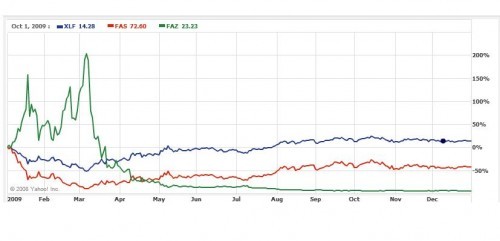Testing a Leveraged ETF Strategy
Post on: 1 Май, 2015 No Comment

Leveraged ETFs remain a spectacularly controversial area, generating much passion on both sides of the question. Frankly, I think its starting to get a bit boring with each side shouting in print at the other but essentially rehashing the same points. Today, Id like to offer a change in the nature of the debate.
Where weve been
Opponents point out that the returns one could expect from holding for more than a day depend not just on the overall direction of the benchmark, but on what sort of zigs and zags it takes to get there. Anecdotes are offered showing how, for example, people could lose money in an ultra-short ETF even if the benchmark declines.
Others, including myself, believe the opponents are convicting the ETFs for failure to deliver on promises the ETFs never made. These vehicles are supposed to double their benchmarks (or the inverse of the benchmark if its a short ETF) on a one-day basis, not necessarily over prolonged holding periods. Clearly, that makes them suitable for day-trading (there is general tracking error, but not so much as to seriously detract from a strategy).
I would go further and suggest these ETFs can be held for longer than a day. The extent to which such a strategy will deviate from expectations depends on the length of the holding period, the number of counter-trend moves within the period (e.g. up days during the course of a bear market), the pattern in which such counter-trend moves occur, and the strength of the overall full-holding-period move (the stronger the move, the more likely it will be to overwhelm counter-trend moves).
Strategic uncertainty
Some readers who posted adverse comments in response to other Seeking Alpha articles I posted on this topic (see here and here ) were particularly bothered by my suggestion that it was OK to tolerate an uncertain degree of deviation from a strategic goal. Simply put, they felt that if one buys an ultra short and the market drops 30% in three months, theyd better see a 60% gain from their ETFs, or if not exactly that, then something pretty darn close. A 10% gain would, according to their approach, be absolutely unacceptable.
If were talking theory, they are spot on. But in the real world, I think theyre living a fantasy.
How many equity investments anywhere any time hit their targets? Do we really have to dig up all the old Wall Street target price projections and see how they turned out? Do we really have to dive into the topic of EPS estimates and review how reliable they are? Do we really have to review the reasons why the notion of estimate revision has spawned a cottage industry in its own right? Do we really have to dissect discounted cash flow and the capital asset pricing model and see how expectations produced by those models have been panning out? Heck, lets forget 2008 and even 2007. How have equity expectations been panning out even under more normal conditions?
Yes, strategies based on ultra ETFs produce missed targets, sometimes small errors, sometimes large errors. But Ill bet that if we compare the misses here, with misses elsewhere in the equity world, ultra ETFs will look no worse, and may even fare better, than most others.
Asking the right question
I think much of the controversy surrounding leveraged ETFs results from focusing on the wrong topic.
The question isnt really whether these ETFs have a tendency to miss investors targets. (I need to reiterate, here, were not talking about the ETFs official targets; the daily doubling of the benchmark. The ETFs do a great job hitting those, at least when we look at market closing prices; intra-day is a separate discussion. The targets were talking about here are those created by investors who may or may not have bothered to actually look at what the ETFs were designed to do, the desire to double a benchmark over much longer holding periods.)
I believe the correct question is whether a leveraged-ETF strategy can produce desirable results for the investor relative to other strategies.
Portfolio123.com just released ETF screening in beta form. And as is the case with equities, the Portfolio123 ETF screener includes backtesting. So I decided to jump right in with the ultras.
Backtesting a leveraged ETF portfolio
I set up an ETF screen based on the following tests:
- ETF Family = ProShares
- Asset Class = Equities
- Region = North America
- Country = United States
- Sector = General (I want to eliminate ETFs that will be influenced by sector-specific issues)
- If my market timing model is bullish (see below), Method = Leveraged Long
- If my market timing model is bearish (see below), Method = Leveraged Short
The market timing model is one I previously developed on Portfolio123 for use with equities. Its bullish if the simple 5-week moving average of the S&P 500 current-year EPS estimate is above the 21-week moving average, and if the S&P 500 risk premium is at least 1%. If either of those conditions are not met, the model is considered to be bearish. (Click here for further discussion .)
Each time the screen is run, I select the top three ETFs using a sort based on 5-day exponential moving average minus the 10-day average. I assume transaction prices based on the average of the next days high and low, and I then assume 0.25% slippage on each trade. These portfolios are rebalanced every four weeks. The test began 7/22/06, when leveraged ETFs started trading, through 3/8/09.
Figure 1 and Table 1 show the results.














